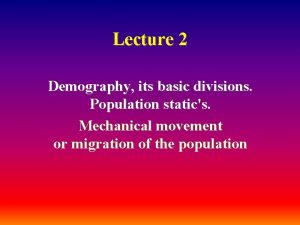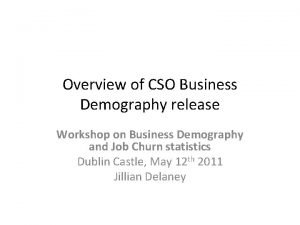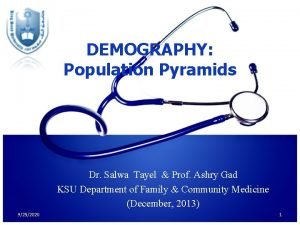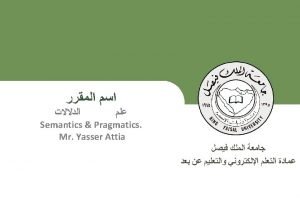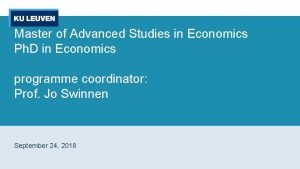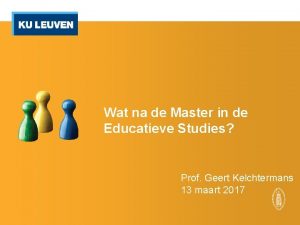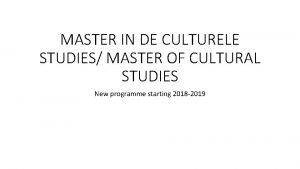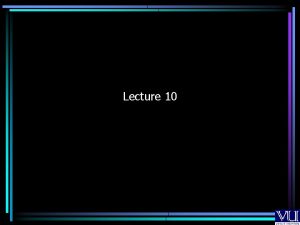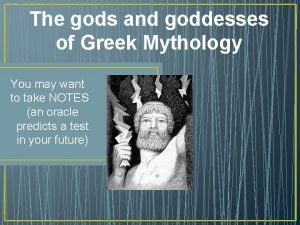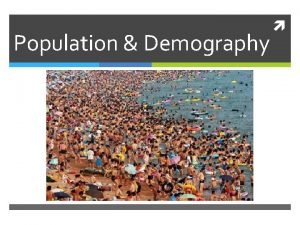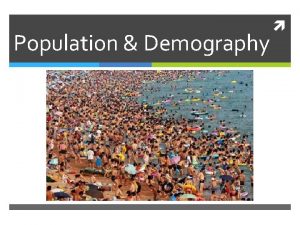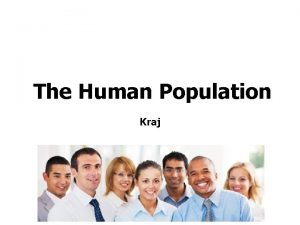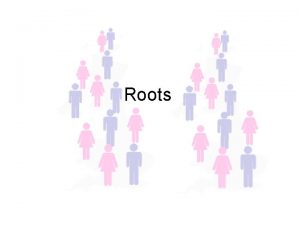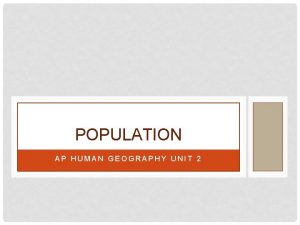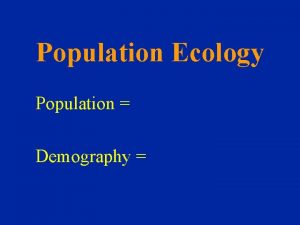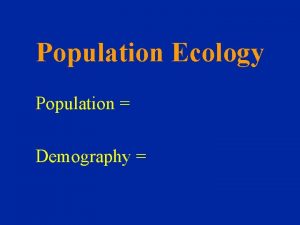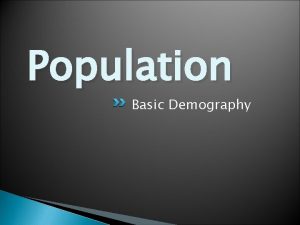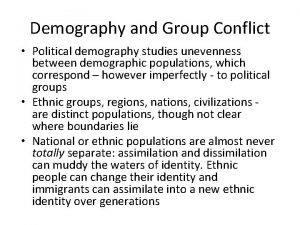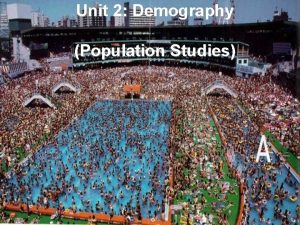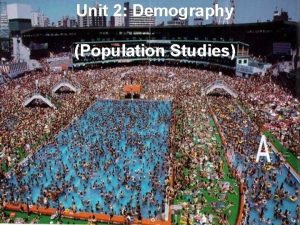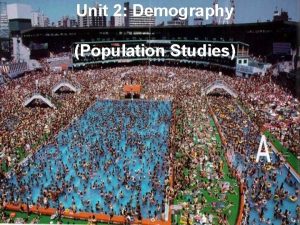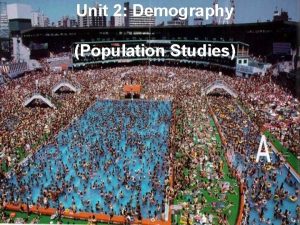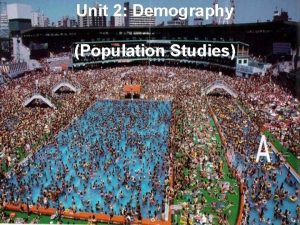LONG YAV Master of Population Studies Demography SESSION

























- Slides: 25

LONG YAV Master of Population Studies (Demography) SESSION 1: INTRODUCTION TO DEMOGRAPHY

LONG YAV Master of Population Studies (Demography) INTRODUCTION AND CONCEPTS Demography is derived from the Greek word “Demo” meaning human being or human population. This term seems to have been coined for the first time by a Belgian statistician Achille Guillard in 1855 in the article entitled “Eléments de statistique humaine, ou démographique comparée” (Shryock and Siegel, 1971) The study of human population is known by two terms: Demography and Population studies and these two terms are often used interchangeably.

LONG YAV Master of Population Studies (Demography) INTRODUCTION AND CONCEPTS Ø Demography: A scientific study of human population focusing on population size, population structure or composition, population events and population characteristics. Ø Population studies: The study of the relationship between demographic variables and other variables such as social and economic variables.

LONG YAV Master of Population Studies (Demography) Other definitions of demography: Ø The empirical, statistical and mathematical study of human population: changes in size, composition, & distribution of population in space. Ø The quantitative study of demographic processes: fertility, mortality, marriage, and migration

LONG YAV Master of Population Studies (Demography) DEVELOPMENT OF DEMOGRAPHY Population studies emerged as a discipline in England in the middle of the 17 century. Ø John Graunt: Natural and Political Observations made upon the Bills of mortality, published in London in 1662. His observations mainly contained a quantitative analysis of mortality. Ø Edmund Halley (1665 -1742), an English astronomer, constructed the first empirical life table in 1693 based on the data of births and deaths.

LONG YAV Master of Population Studies (Demography) Ø Gregory King (1648 -1712), another English scholar contributes to the discipline by estimating the population of England Wales. Ø Achille Guillard (1790 -1876) wrote an article “Eléments de statistique humaine ou démographique comparée”(Elements of human statistics or comparative demography). Ø Some scholars in eighteen century observed the relationship between the potentiality of population growth and available resources and arrived at the conclusion that the potentialities of human population growth might surpass the resources required for its support e. g. Hung Liang-Chi and Thomas R. Malthus.

LONG YAV Master of Population Studies (Demography) Ø Hung Liang-Chi, noted that an increased in the means of subsistence was not in direct proportion to that of the population in the eighteenth century. Ø Godwin, M. Condorcet and other writers by Thomas R. Malthus (1766 -1834) wrote an essay in 1798 on principles of population stating that man could increase his subsistence only in arithmetical progression and his numbers tended to increase in geometrical progression. Ø The United States of America had its first census in 1790 and England France in 1801. Ø In 1922, A. M. Carr-Saunders, a biologist, published his book, the population problem, containing a systematic statement of the problems of population size and growth and a discussion of the genetic question.

LONG YAV Master of Population Studies (Demography) RELATIONSHIP WITH OTHER SUBJECTS STATITICS LAW Mathematic Model Theory of to est. population Probability on growth Mortality Population Policy/law: Fertility, mortality, migration, DEMOGRAPHY health, sanitation etc. FP, fertility Population & Development, regulation & man power RH behavior of individuals study ECONOMICS PSYCHOLOGY GEOGRAPHY Geographical population distribution & its movement Fertility with connect to attitudes & social institutions SOCIOLOGY MATHEMATICS Fecundity, SR & age-sex diff. in Mortality BIOLOGY

LONG YAV Master of Population Studies (Demography) SOURCES OF DEMOGRAPHIC DATA Population Census, Vital Registration & Sample Survey 1. Population Census: The total process of collecting, compiling and publishing of demographic, economic and social data pertaining to a specify time or times of all persons in a country or delimited territory (The United Nations). Ø Essential Characteristics: Universality, Simultaneity, and Individual enumeration

LONG YAV Master of Population Studies (Demography) History of Census Ø Census is derived from Greece word Censere, meaning to value or tax: • • • Egypt 3000 B. C. “Census” every other year. They list of families and other occupants of houses for certain particular cases (e. g. , soldiers) Greece: count of males 18 years and older Rome: Enumeration of every family every five years for taxation purposes. Modern census Format emerged gradually around 1600 s in Europe. Quebec 1666

LONG YAV Master of Population Studies (Demography) Ø Census can be conducted in every 5 or 10 years: - De facto: count population according to where they are staying at the time of census enumeration or the night before, irrespective of their usual place of residence. - De jure: collect information about all the persons who usually live in a household, whether or not they are present at the time of enumeration.

LONG YAV Master of Population Studies (Demography) DATA COLLECTION Ø Establish administrative tree (census officers, supervisors, enumerators) Ø Develop questionnaire(s) Ø Cartography Ø Define enumeration areas Ø Pretest enumeration processes Ø Design data processing system Ø Enumeration (postal with follow-up, general canvas)

LONG YAV Master of Population Studies (Demography) Ø Census contains 1. 2. 3. Ø Demographic data e. g. , age and sex Economic data e. g. , occupation and income Social data e. g. , education and housing Census record information at: 1. Individual Level: name, age, sex, relationship to the head of household, marital status, religion, education, employment status, occupation and migration etc. 2. Household Level: housing condition and amenities, # of children ever born, children still alive and the births during the one year period during the census time, and employment status etc.

LONG YAV Master of Population Studies (Demography) Advantages Ø Universal, hence small area data available Ø National effort Ø Provides frame for later sample surveys Ø Provides population denominators Disadvantages Ø Size limits content and quality control efforts Ø Cost limits frequency Ø Delay between field work and results Ø Sometimes politicized

2. Sample Survey LONG YAV Master of Population Studies (Demography) Ø Sample Survey involves taking a sample of the population to be enumerated with more trained investigators interviewing them more intensely in a few selected areas. Ø Purposes: Obtain information from a sample representative of some population. Ø Essential Characteristics: 1. Representative sample of some population 2. Smaller size than census allows collection of more indepth information that can then be generalized

LONG YAV Master of Population Studies (Demography) Two types of sample survey: 1. Single-round retrospective Ø Ø Ø 2. Census-type household surveys Focused, (e. g. , Contraceptive Prevalence Survey (CPS)) Birth/Maternity history (World Fertility Survey (WFS), Demographic and Health Survey (DHS)) Multi-round follow-up (prospective)

LONG YAV Master of Population Studies (Demography) SAMPLING METHODS Ø Sampling frame, generally from census Ø Separate strata are often defined for sampling. The provinces, urban and rural areas could be strata. Ø Sample size depends on resources and timing but it has to be representative so that the result can be generalized Ø Sample size calculation: n = Z 2 *p*q / D 2 where n= The sample size z= The number that matches the CI. Z=1. 96 if the 95% CI and z=1. 645 for 90%CI D= The maximum margin of error you decided could be accepted, either. 05 or. 10 p= The estimated proportion you will be measuring. If you do not know the p value, just put it. 5 meaning 50% q=1 -p

LONG YAV Master of Population Studies (Demography) Advantages 1. Single-round retrospective: Can be quick, relatively inexpensive, flexible, can include detailed data, needs little continuity effort 2. Ø Ø Multi-round prospective Some control on coverage and content errors Follow-up allows control for sampling distortion Disadvantages: 1. Single-round retrospective: Coverage and content errors, Misses certain types of events 2. Multi-round prospective: Slow, Needs continuity of effort over (extended) time, High cost

LONG YAV Master of Population Studies (Demography) 3. Vital Registration Ø A system to register demographic events such as birth, death and marriage. Ø Purposes: • Administrative and legal purposes. • Help to understand demographic characteristics of different populations at different points in time. Ø Essential Characteristics: Universality & Continuity

LONG YAV Master of Population Studies (Demography) a. Live birth registration Ø Live birth—Complete expulsion or extraction from its mother of a product of conception, irrespective of the duration of pregnancy, which after such separation, breathes or shows any other evidence of life such as beating of the heart, pulsation of the umbilical cord. Ø All live-born infants should be registered as live birth irrespective of gestation age. Ø The United Nations recommended to register date and place of occurrence, date of registration, type of birth or delivery, sex of the child, weight of the child at birth, legitimacy status, and characteristics of the mother (name, age or date of birth, date or duration of marriage, place of usual residence).

LONG YAV Master of Population Studies (Demography) b. Death registration Ø Death: WHO defines death as permanent disappearance of all evidence of life at any time after live birth has taken place Ø The death is indicated by the lost of evidence of life such as breathing, beating of the heart etc. Ø The United Nations recommended to register date and place of occurrence, date of registration, cause of death, certifier, age or date of birth, sex and marital status, occupation, place of usual residence).

LONG YAV Master of Population Studies (Demography) c. Marriage registration Ø Marriage—Ceremony or process by which the legal relationship of husband wife is constituted. Ø The legality of the union may be established by civil, religious, or other means as recognized by the laws of each country. Ø The United Nations recommended to register date and place of occurrence, date of registration, type of marriage (civil, religious, customary), and data on bride and groom such as age or date of birth, previous marital status, place of usual residence).

LONG YAV Master of Population Studies (Demography) Advantages & disadvantages of vital registration Advantages Ø Continuous monitoring of vital rates Ø May provide both numerator & denominator for rates (e. g. , IMR) Ø Small area data available Ø Base for testing the accuracy of censuses and surveys Disadvantages Ø Uncertain coverage: Difficult to ensure registration of all the events Ø Limited background information Ø Time reference often inconsistent with denominator definition Ø Information may come from third party Ø Easily disrupted by political/economic events Ø Literacy/numeracy Ø Costly

LONG YAV Master of Population Studies (Demography) Cambodian Demographic Data sources 1. Cambodia Population Census in 2008, 1998 & 1962 2. Cambodia Population Projection 2008 and 1998 3. Cambodia Inter-Census in 2004 4. Population count in 1992 by UNTAC 5. Population count in 1980 -81 6. Cambodia Demographic and Health survey (CDHS) in 2010, 2005 and 2000. 7. Cambodia Socio-Economic Survey (CSES) conducted firstly in 1993. The CSES has been conducting annually since 2007.

LONG YAV Master of Population Studies (Demography) THANKS FOR YOUR ATTENTION!
 Population demography definition
Population demography definition Static demography
Static demography Cso business demography
Cso business demography Elements of demography
Elements of demography Exclave ap human geography definition
Exclave ap human geography definition Sources of demographic data
Sources of demographic data Components of demography
Components of demography Slash and burn agriculture antonym
Slash and burn agriculture antonym Tall+short h
Tall+short h Once upon a time there lived a wise old teacher
Once upon a time there lived a wise old teacher Paradigm shift from women studies to gender studies
Paradigm shift from women studies to gender studies Chapter 4 population ecology test answer key
Chapter 4 population ecology test answer key Section 1 population dynamics
Section 1 population dynamics Population ecology section 1 population dynamics
Population ecology section 1 population dynamics Chapter 4 section 1 population dynamics answer key
Chapter 4 section 1 population dynamics answer key Compsci 762
Compsci 762 Mase ku leuven
Mase ku leuven Master educatieve studies
Master educatieve studies Master in de culturele studies
Master in de culturele studies Barry callebaut
Barry callebaut Long long ago people used to think that the earth was
Long long ago people used to think that the earth was Once there lived a king
Once there lived a king Poem about tinikling
Poem about tinikling Once upon a time a long long time ago
Once upon a time a long long time ago Long long int c
Long long int c Long long ago when the gods and goddesses
Long long ago when the gods and goddesses

